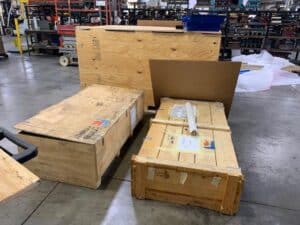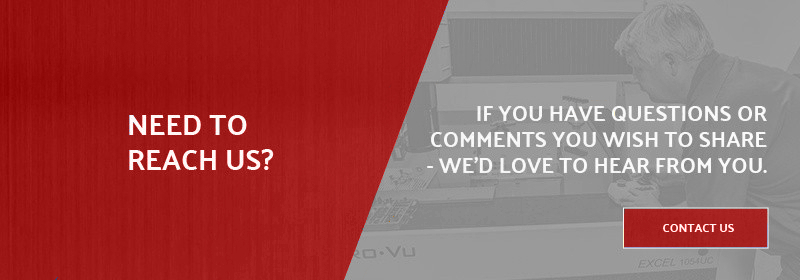Often the packing and packaging of a product is overlooked, adding unforeseen costs. This could potentially turn a good project sour for both the supplier and the customer. It is important to ask a lot of questions particularly at the beginning of a project.
Packaging in the metal fab industry requires collaboration between the supplier, the customer and often a packaging supplier. Understanding the application, durability of the finish and how a part is introduced to an assembly line, can direct a project manager to the appropriate packaging.
 Generally, bulk packing a product is the least expensive choice, particularly in metal stamping. Bulk packing allows for less handling after forming, thus reducing labor by eliminating additional product handling by the supplier. It is important to understand any customer requirements when bulk packing such as weight restrictions and box and pallet requirements. Often these details are available in supplier manuals on a customer’s website.
Generally, bulk packing a product is the least expensive choice, particularly in metal stamping. Bulk packing allows for less handling after forming, thus reducing labor by eliminating additional product handling by the supplier. It is important to understand any customer requirements when bulk packing such as weight restrictions and box and pallet requirements. Often these details are available in supplier manuals on a customer’s website.
 This option in packaging is becoming more frequently utilized. Returnable packaging is a great option for projects with volume and resources. It requires upfront costs for the bins and the coordination in returning bins to suppliers, but many more customers are moving in this direction for long-term cost savings and footprint reduction.
Additionally, the environmental savings on eliminating disposable cardboard boxes is attractive for both customers and suppliers.
The goal at R&M Manufacturing is to meet our customer’s expectations in line and shipping efficiencies when they have a product ready to go. Our team is ready to help bring your project from prototype to production, by assisting you with all of the steps in-between.
This option in packaging is becoming more frequently utilized. Returnable packaging is a great option for projects with volume and resources. It requires upfront costs for the bins and the coordination in returning bins to suppliers, but many more customers are moving in this direction for long-term cost savings and footprint reduction.
Additionally, the environmental savings on eliminating disposable cardboard boxes is attractive for both customers and suppliers.
The goal at R&M Manufacturing is to meet our customer’s expectations in line and shipping efficiencies when they have a product ready to go. Our team is ready to help bring your project from prototype to production, by assisting you with all of the steps in-between.
BULK PACKING
 Generally, bulk packing a product is the least expensive choice, particularly in metal stamping. Bulk packing allows for less handling after forming, thus reducing labor by eliminating additional product handling by the supplier. It is important to understand any customer requirements when bulk packing such as weight restrictions and box and pallet requirements. Often these details are available in supplier manuals on a customer’s website.
Generally, bulk packing a product is the least expensive choice, particularly in metal stamping. Bulk packing allows for less handling after forming, thus reducing labor by eliminating additional product handling by the supplier. It is important to understand any customer requirements when bulk packing such as weight restrictions and box and pallet requirements. Often these details are available in supplier manuals on a customer’s website.
LAYER OR NEST PACKING
Although layer or nest packing can increase costs, there’s also an increased benefit. Generally, this process is used when cosmetics of a part or part handling at the assembly line become important. By nesting parts, the chance of them touching during shipment can be reduced. Nesting also allows for easier picking at the line. Lastly, it can allow for a more accurate count of parts when compared to bulk packing which is often packed based on weight. An added feature when layer packing, is individually wrapping parts. By individually wrapping, the benefit of protective dunnage to further protect parts from part-to-part touching while shipping is increased. Often found with painted or specialty plated parts where cosmetics of the finished product are important, wrapping comes in all forms from foam to paper to bubble wrap. Project managers must account for the additional cost in dunnage as well as the labor to wrap the product.RETURNABLE PACKAGING
 This option in packaging is becoming more frequently utilized. Returnable packaging is a great option for projects with volume and resources. It requires upfront costs for the bins and the coordination in returning bins to suppliers, but many more customers are moving in this direction for long-term cost savings and footprint reduction.
Additionally, the environmental savings on eliminating disposable cardboard boxes is attractive for both customers and suppliers.
The goal at R&M Manufacturing is to meet our customer’s expectations in line and shipping efficiencies when they have a product ready to go. Our team is ready to help bring your project from prototype to production, by assisting you with all of the steps in-between.
This option in packaging is becoming more frequently utilized. Returnable packaging is a great option for projects with volume and resources. It requires upfront costs for the bins and the coordination in returning bins to suppliers, but many more customers are moving in this direction for long-term cost savings and footprint reduction.
Additionally, the environmental savings on eliminating disposable cardboard boxes is attractive for both customers and suppliers.
The goal at R&M Manufacturing is to meet our customer’s expectations in line and shipping efficiencies when they have a product ready to go. Our team is ready to help bring your project from prototype to production, by assisting you with all of the steps in-between. 
